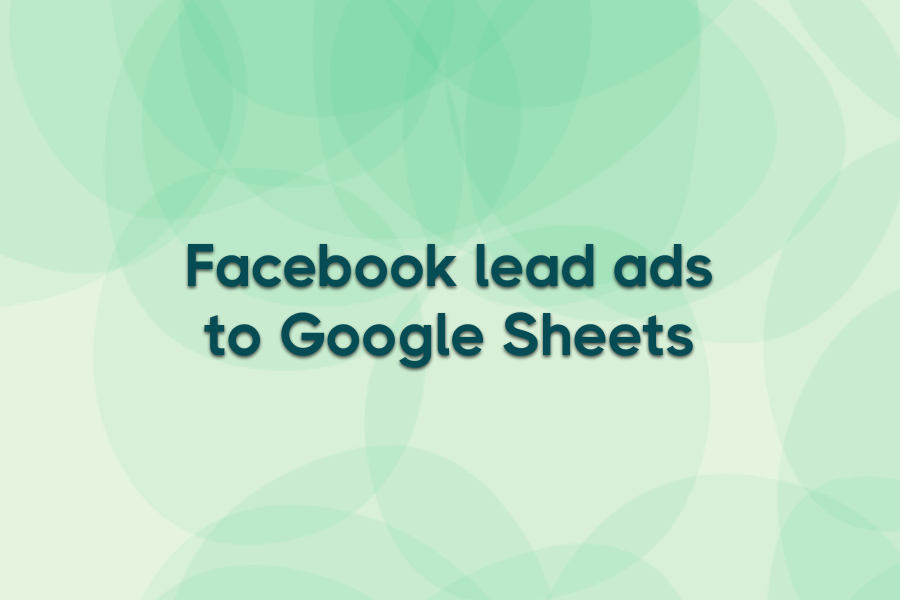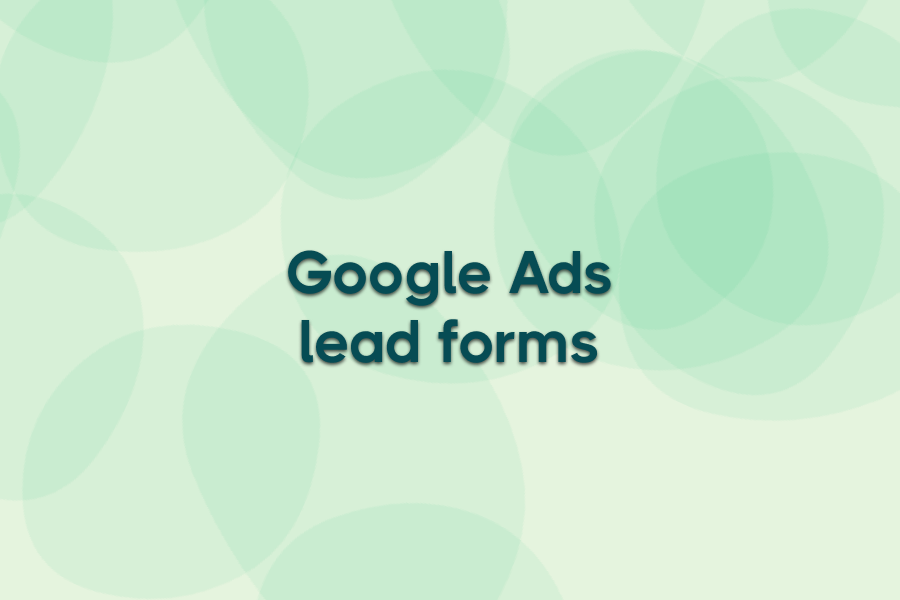If you're looking for a faster way to get Facebook Lead Ads into Google Sheets — without code, without delays — you're in the right place.
In this guide, we’ll walk you through the easiest ways to automate that connection using tools like Zapier, Make, and dedicated lead sync platforms.
We’ll also cover where these methods fall short, and why tools built specifically for real-time lead delivery — like Ads Workbench — might be a better long-term fix.
Let’s break it down.
How to connect Facebook Lead Ads to Google Sheets: 4 reliable methods
There are a few reliable ways to automate Facebook lead delivery into Google Sheets — no manual downloads or CSV exports required. Here, we’ll walk you through the most popular.
1. Using Zapier to send Facebook Lead Ads to Google Sheets
Zapier is one of the most popular tools for automating Facebook Lead Ads delivery to Google Sheets. The setup is simple: you create a “Zap” where the trigger is a new Facebook lead, and the action is adding that lead to a Google Sheets row.
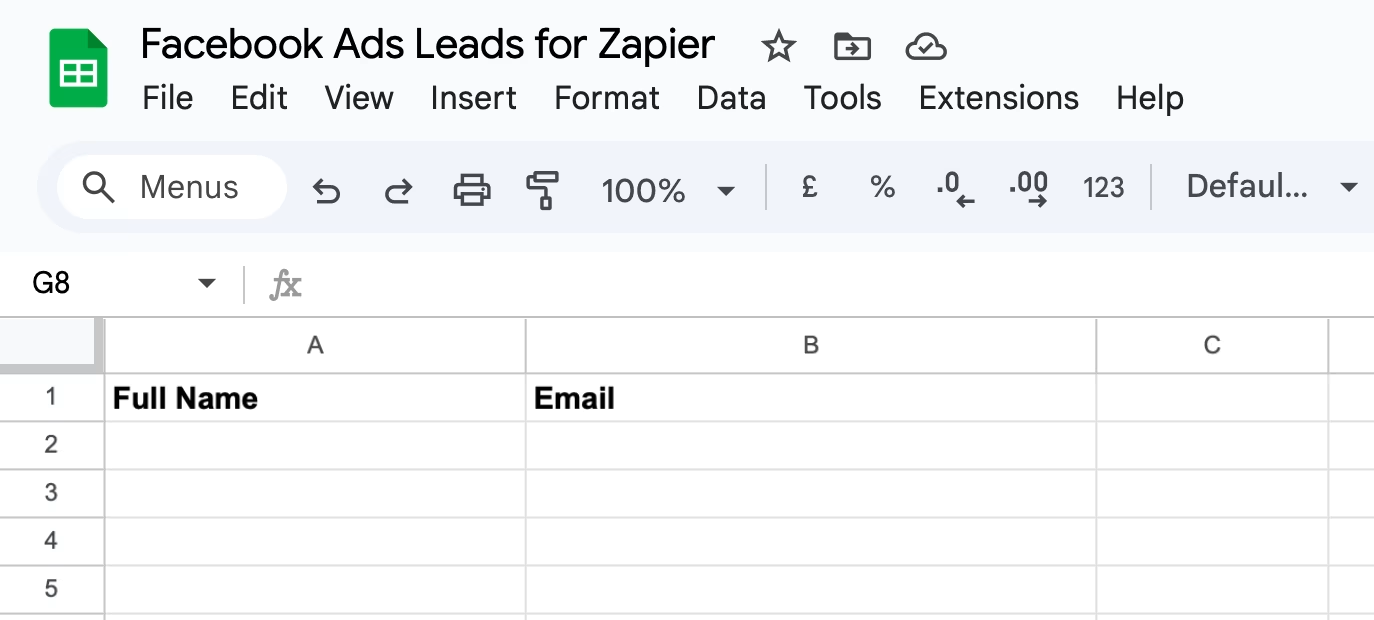
Courtesy of Zapier
To use it:
- Connect your Facebook Ads account and Google account to Zapier
- Choose your form and target spreadsheet
- Map form fields (e.g. name, email, phone) to spreadsheet columns
It’s a solid choice for basic flows, but it can get expensive fast as lead volume grows — and Zapier’s polling delays mean you may not get leads in real time.
2. Using Make (formerly Integromat)
Make is a visual automation platform that offers more flexibility than Zapier — and it can handle Facebook Lead Ads to Google Sheets quite well. You build “scenarios” using a flowchart-style editor, connecting Facebook as a trigger and Google Sheets as the destination.
To use it:
- Authenticate Facebook and Google Sheets in Make
- Build a scenario using the Facebook Lead Ads module
- Add a Google Sheets module to insert lead data row by row
Great for technical users; less so for teams that want fast setup and minimal maintenance.
3. Using Ads Workbench (fastest setup, built for marketers)
Ads Workbench is built specifically for syncing Facebook Lead Ads to destinations like Google Sheets — without coding, delays, or clunky logic builders. Unlike Zapier or Make, it doesn’t poll for leads. Instead, it pushes them in real time, so your team gets every lead instantly.
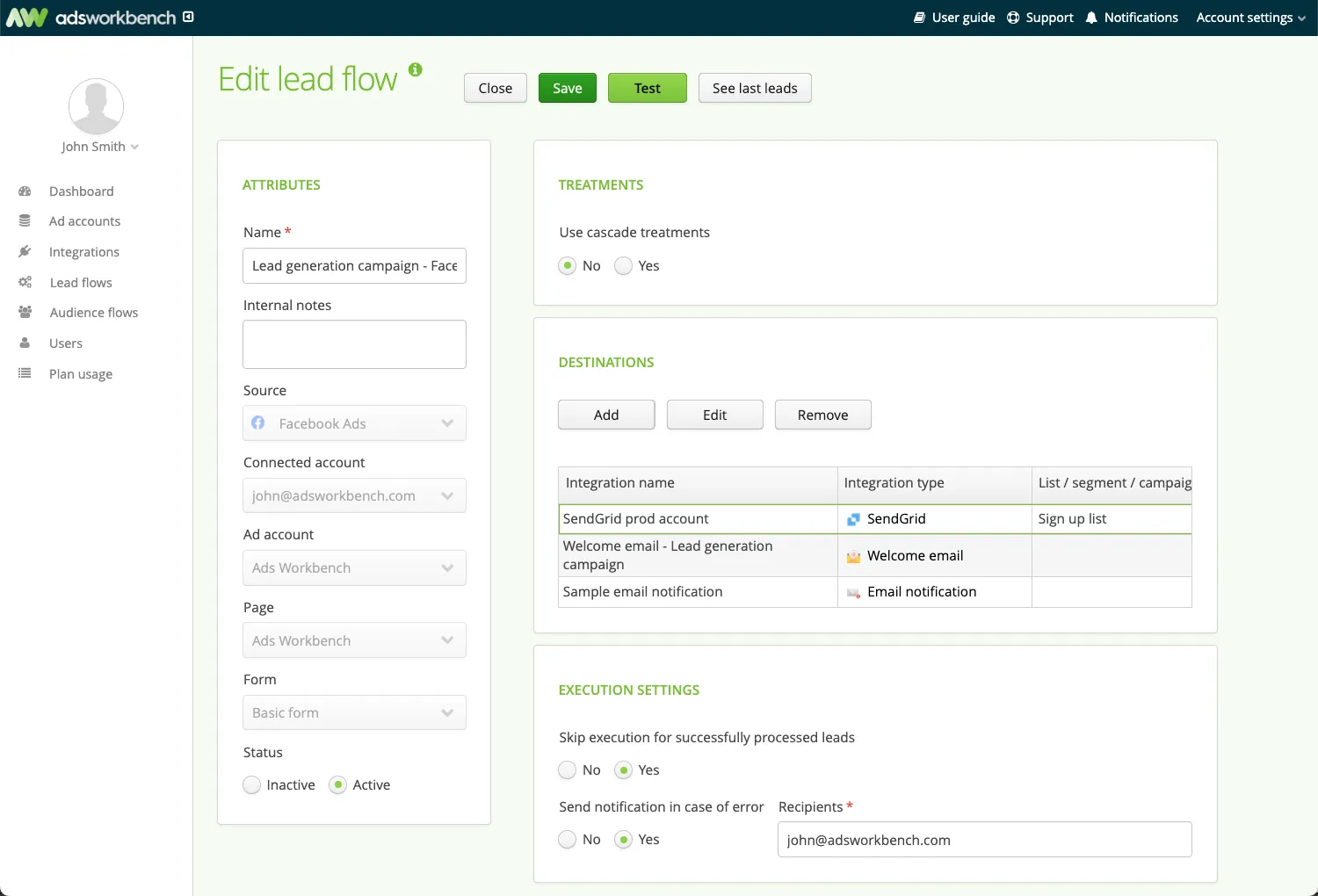
To set it up:
- Connect your Facebook ad account and Google Sheets
- Choose your lead form and map fields to your sheet
- Turn it on — that’s it
You can also set up Slack or email alerts, route leads to a CRM, or explore other powerful Facebook business integrations that enhance lead sync and audience targeting. It’s ideal for agencies and growth teams that need fast, reliable lead flow without the maintenance overhead.
4. Manual CSV export from Meta Ads Manager
If you're not ready to use an automation tool, Facebook does allow you to download leads manually — but it’s a clunky, time-consuming process. To do it:
- Go to Meta Ads Manager and find your lead ad campaign
- Click into the ad set, then the specific lead form you used
- Under the “Leads” column, click Download
- Choose CSV as the format, then upload or paste the leads into Google Sheets manually
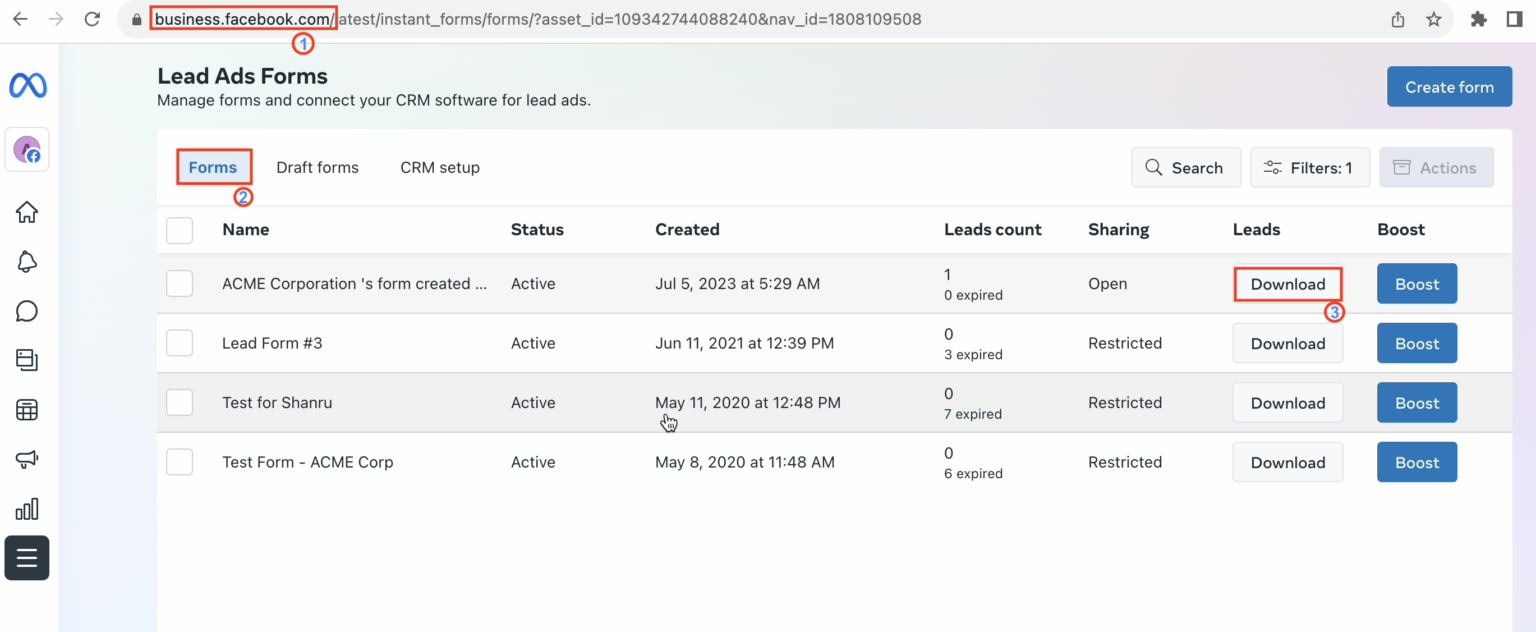
It works, but it doesn’t scale. You have to repeat this for each form, and there’s no notification when new leads arrive. If you’re running multiple campaigns or need fast follow-up, this approach quickly becomes unmanageable.
Why Google Sheets falls short for real-time lead delivery
Google Sheets is a flexible tool, for sure. But when it comes to lead delivery, it's far from flawless. Below are some of the most common issues marketers and growth teams run into when using Sheets to manage Facebook leads.
1. No real-time sync
Google Sheets doesn’t support instant delivery. Most setups rely on polling (e.g. Zapier every 15 minutes), which introduces lag. That delay means slower follow-up, lower lead quality, and missed opportunities — especially for sales teams that need to act fast.
2. Breakable or brittle automations
Even small changes — like renaming a column or editing a form — can silently break your flow. Most tools won’t notify you when it happens. Unless you're checking constantly, it’s easy to lose leads without realizing it.
3. No routing or notifications
Leads sent to a spreadsheet just sit there. There’s no alert, no assignment, no CRM push — unless you bolt on extra tools. Without automated routing, teams are left checking Sheets manually or reacting late to leads that needed a quick follow-up.
4. Manual maintenance at scale
As forms and campaigns multiply, so do the spreadsheets. Managing them — mapping fields, keeping logic updated, avoiding duplicates — soon gets tedious. Fast. Sheets work for simple use cases, but they’re a poor fit for multi-form, multi-client environments.
5. Privacy and access risks
Lead data in Google Sheets is easy to share. Sometimes too easy. Without role-based access or logging, sensitive contact info can be exposed to anyone with the link. That’s a real risk for teams handling personal or regulated data.
For small teams and simple flows, Sheets might be enough. But as lead volume, urgency, or compliance requirements grow, so do the risks and limitations. That’s when it makes sense to consider a more purpose-built solution.
Skip the delays: what Ads Workbench does differently
Google Sheets might work for basic lead capture, but if you're tired of delays, missing leads, or clumsy workarounds, Ads Workbench offers a better way.
Here’s what it looks like in action:
1. Connect Facebook Lead Ads
Once you're logged in, go to the Ad accounts section in Ads Workbench. Click Connect account → Facebook Ads and follow the prompts to log in and authorize access. Grant permission for Ads Workbench to manage and sync Lead Ads — this enables seamless data transfer into Google Sheets.
2. Connect your Google Sheets account
From the main menu, head to Integrations, click Create new, enter a name, and select Google Sheets as the integration type. Click Authorize, then sign in (or pick) your Google account. Click Allow when prompted. Ads Workbench will redirect back, and your Sheets integration is now ready
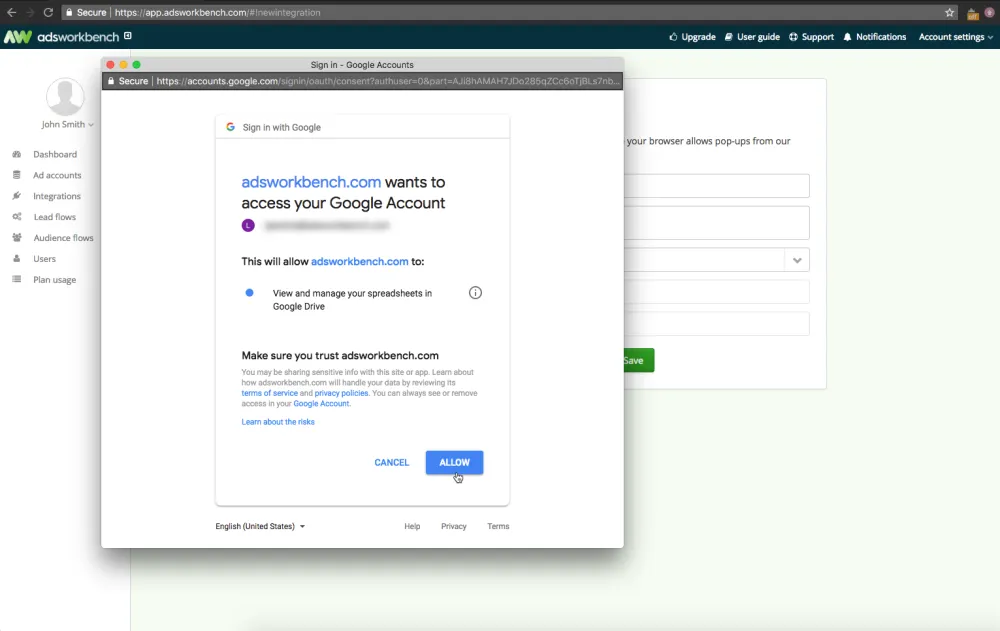
3. Set up automated data sync with a lead flow
With both your Facebook and Google Sheets accounts connected, you're ready to create the automation that keeps leads moving—seamlessly and in real time.
3. 1 Create a lead flow
- Click Create new to start a new lead flow.
- Enter a name (e.g. “Facebook → Sheets Sync”).
- Select Facebook Lead Ads as your source.
- Choose the connected Facebook ad account, select the corresponding Page, and pick the lead form you want to sync.
- Click Next to move to the destinations section.
3.2 Add Google Sheets as a destination
- Click Add destination.
- From the list of connected integrations, select your Google Sheets integration.
- Enter the Spreadsheet ID and the Sheet name (case-sensitive).
- Spreadsheet ID is found in the URL between /d/ and /edit.
- Sheet name must match exactly the tab name in your spreadsheet.
3.3 Complete data mapping
- Ads Workbench will automatically map standard fields like email, first name, and last name if they match your sheet’s columns.
- Add any additional fields – such as campaign name, ad set, or custom hidden fields from Facebook.
- You can also set fixed values or mappings for UTM parameters or custom data—then save the mapping.
3.4 Adjust execution settings
- Choose behavior for duplicate leads: whether to skip or update existing entries.
- Add email recipients to notify in case of process errors.
- Use the Test execution button to validate mapping and formatting before publishing.
3.5 Activate and save the flow
- Switch the flow status from Inactive to Active.
- Click Save to finalize.
- Once active, leads will start populating your Google Sheet in real time. You can monitor and review recent lead executions or statuses via the dashboard.

But the real value goes beyond setup.
- Your leads show up in Sheets the second they’re submitted — not 15 minutes later.
- You don’t need Zapier, webhook code, or extra routing tools.
- You can also sync the same lead to your CRM, trigger alerts in Slack, or build audiences for retargeting — all from the same setup.
- Ads Workbench doesn’t store lead data, so you maintain full control and stay privacy-compliant by design.
- You never worry about broken automations or silent failures.
It’s not just a connection — it’s a workflow fix. Built for speed, reliability, and control.
Ready to stop patching your lead flow?
A lead fills out your form. Where does it go?
If the answer is “a spreadsheet we check sometimes,” you're leaving money on the table. Leads go cold fast. Manual systems don’t warn you when they fail. And patching things together with Zapier or Sheets only works until it doesn’t.
Ads Workbench gives you a direct line — from form to follow-up. No delays. No silent errors. No guessing.
You get every lead, the moment it comes in. Your team sees it, acts on it, and moves faster than the competition.
That’s what a real system feels like.
Got five minutes to replace hours of lead cleanup and second-guessing? Start your free trial today.

